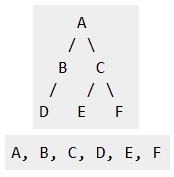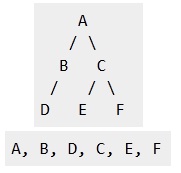BFS vs. DFS
BFS
|
DFS
|
| BFS Stands for “Breadth First Search”. |
DFS stands for “Depth First Search”. |
| BFS starts traversal from the root node and then explore the search in the level by level manner i.e. as close as possible from the root node. |
DFS starts the traversal from the root node and explore the search as far as possible from the root node i.e. depth wise. |
| Breadth First Search can be done with the help of queue i.e. FIFO implementation. |
Depth First Search can be done with the help of Stack i.e. LIFO implementations. |
| This algorithm works in single stage. The visited vertices are removed from the queue and then displayed at once. |
This algorithm works in two stages – in the first stage the visited vertices are pushed onto the stack and later on when there is no vertex further to visit those are popped-off. |
| BFS is slower than DFS. |
DFS is more faster than BFS. |
| BFS requires more memory compare to DFS. |
DFS require less memory compare to BFS. |
Applications of BFS
> To find Shortest path
> Single Source & All pairs shortest paths
> In Spanning tree
> In Connectivity |
Applications of DFS
> Useful in Cycle detection
> In Connectivity testing
> Finding a path between V and W in the graph.
> useful in finding spanning trees & forest. |
| BFS is useful in finding shortest path.BFS can be used to find the shortest distance between some starting node and the remaining nodes of the graph. |
DFS in not so useful in finding shortest path. It is used to perform a traversal of a general graph and the idea of DFS is to make a path as long as possible, and then go back (backtrack) to add branches also as long as possible. |
Example :  |
Example :
 |
used to perform a traversal of a general graph.
The idea of DFS is to make a path as long as possible, and then go back (backtrack) to add branches also as long as possible.